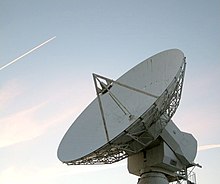Communications engineering
The communications technology is an engineering science , which as a branch of electrical recording, transmission and storage of messages ( Information busy). As in almost all areas of technology, digital technology , especially digital signal processing , has strongly influenced communications technology , which used to be based purely on analog technology , and led to improvements in a large number of areas.
Definition and demarcation
Communication engineering deals with the acquisition, conversion, transmission, switching, storage and output of information- carrying signals . The main task of communications engineering is to transmit information from one or more information sources to one or more sinks as accurately as possible. In addition to numerous other disciplines, telecommunications also belong to telecommunications . Telecommunications is the exchange of information between spatially distant information sources and sinks using communications systems. In practical terms, in a telephone conversation between two people with cell phones, the system consisting of the cellular network and the two (strictly speaking: all cell phones registered in the network) is the telecommunications system. Both telephones are always the source of information and the information sink at the same time.
Telecommunications / communication technology is occasionally confused with communication science . Communications technology deals with the technical systems for communication , while communication science deals with communication between entities that use these technical means - generally between people, but also between machines such as B. Computers. A sub-area is mass media content such as information broadcasts that are distributed via communications systems such as radio , but also via traditional media such as newspapers.
history
As a result of new scientific findings and technical developments, the possibilities of communications technology have expanded enormously and continue to do so, see for example the development from wired landline telephony in the 1980s to today's mobile telephony with multimedia- capable smartphones . This development was also expressed in the change in the name of this engineering discipline. Initially speaking of weak-current technology , the name telecommunications technology was coined around 1909 by Rudolf Franke . Today we also speak of information and communication technology .
Sub-areas
Communication engineering covers a very large area of responsibility, so that a whole series of sub-areas has emerged.
Technical sub-areas:
- Antenna technology
- electronic data processing
- Filter technology
- Radio technology
- Channel coding
- modulation
- amplifier
- Circuit technology
- Signal processing
- digital signal processing
- telecommunications
- Transmission technology
- laser
- sound
- Switching technology
- Computer networks
- services
- Mobile communication
- High frequency technology
- Sensors
- Radar technology
- Location
- correlation
- Terminal technology
Theoretical basis:
Frequency ranges
A distinction is made in communications technology according to the frequencies used
- Low frequency technology ( sound technology )
- High-frequency technology ( radio and television technology , directional radio , mobile radio , satellite communication )
- Microwave technology ( radar )
- Category: Optical communications technology ( laser , fiber optic cable )
Areas of application
Until a few years ago, the largest man-made machine was a communications system, namely the worldwide telephone network . At the moment the telephone network is going through a transition phase and is being absorbed into another, even larger telecommunications system, the Internet , without the broader public being aware of this. The telephone network, after it served as access technology to the Internet for a while, is or has become part of the Internet itself, and is fundamentally changing technologically and structurally in the process. This process has largely been completed in Germany and other western industrialized countries . For example, by the end of 2018, Deutsche Telekom had switched the landline network, including, above all, the technical infrastructure for telephone and long-distance data connections throughout Germany to Internet-based IP telephony and all connections to VDSL technology. The only change for normal landline telephone customers is that their previous landline telephone may now be connected to a DSL router with the same or expanded functionality.
The Internet is an example of the smooth transition from telecommunications to computer science . On the one hand, communications systems are often important components in the computer systems of technical and applied IT, on the other hand, modern communications systems are often based on theories and processes of IT and are essentially computer systems.
See also
literature
- Martin Bossert: Introduction to communications technology. Oldenbourg, Munich 2012, ISBN 978-3-486-70880-6 .
- Wolfgang Frohberg, Horst Kolloschie, Helmut Löffler : Paperback of communications engineering. Fachbuchverlag Leipzig in Carl Hanser Verlag, Munich 2008, ISBN 978-3-446-41602-4 .
- Martin Werner: communications engineering . An introduction to all courses, 8th edition, Springer Vieweg Verlag, Wiesbaden 2017, ISBN 978-3-8348-2580-3 .
- Eberhard Herter, Wolfgang Lörcher: Communication technology . Transfer - mediation - processing, Carl Hanser Verlag, Munich 2004, ISBN 978-3-4462-2684-5 .
- Helmuth Wilhelms, Dieter Blank, Hans Mohn: Electrical specialist 3 Telecommunications . 1st edition. BG Teubner Verlag, Stuttgart 1982, ISBN 3-519-06807-9 .
- Volker Aschoff: History of communications engineering . Volume 1, Springer Verlag, Berlin / Heidelberg 1989, ISBN 978-3-642-86849-8 .
- Gerhard K. Grau: Optical communication technology . An introduction, 2nd edition, Springer Verlag, Berlin / Heidelberg 1986, ISBN 978-3-540-15802-8 .
- Frank Haase: Kleist's communications technology . A discourse analysis, Westdeutscher Verlag, Opladen 1986, ISBN 978-3-531-11825-3 .
- Dieter Stoll: Circuits in communications engineering . Friedrich Vieweg & Sohn Verlag, Braunschweig 1988, ISBN 978-3-663-00131-7 .
Web links
- Literature on communications technology in the catalog of the German National Library
Individual evidence
- ↑ Landline / Telephone Network , Electronics Compendium, accessed on May 6, 2020
